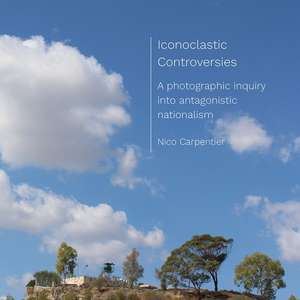Iconoclastic Controversies: A Photographic Inquiry into Antagonistic Nationalism
Autor Nico Carpentieren Limba Engleză Paperback – 24 aug 2021
The book combines photography and written text to analyze the role of memorials and commemoration sites in the construction of antagonistic nationalism. Taking Cypriot memorializations as a case study, the book shows how these memorials often support, but sometimes also undermine, the discursive-material assemblage of nationalism.
Preț: 231.40 lei
Nou
Puncte Express: 347
Preț estimativ în valută:
44.28€ • 48.09$ • 37.20£
44.28€ • 48.09$ • 37.20£
Carte disponibilă
Livrare economică 01-15 aprilie
Livrare express 15-21 martie pentru 29.31 lei
Preluare comenzi: 021 569.72.76
Specificații
ISBN-13: 9781789384550
ISBN-10: 1789384559
Pagini: 166
Ilustrații: 16 color plates, 62 halftones
Dimensiuni: 222 x 222 x 15 mm
Greutate: 0.44 kg
Editura: Intellect Ltd
Colecția Intellect Ltd
ISBN-10: 1789384559
Pagini: 166
Ilustrații: 16 color plates, 62 halftones
Dimensiuni: 222 x 222 x 15 mm
Greutate: 0.44 kg
Editura: Intellect Ltd
Colecția Intellect Ltd
Notă biografică
Nico Carpentier is extraordinary professor at Charles University in Prague and associate professor at Vrije Universiteit Brussel in Belgium. He is the coeditor of several books, most recently Communication and Discourse Theory: Collected Works of the Brussels Discourse Theory Group, also published by Intellect.
Cuprins
Chapter 1:
An Introduction to Iconoclastic Controversies
Chapter 2:
Communicating Academic Knowledge Beyond the Written Academic Text
Chapter 3:
On Antagonism and Nationalism—A Discursive-Material Re-Reading
Chapter 4:
The Discourses and Materialities of Cypriot Antagonistic Nationalism
Chapter 5:
The Iconoclastic Controversies Photographs
Chapter 6:
The Reception of the Two Cypriot Exhibitions
with Vaia Doudaki, Yiannis Christidis and Fatma Nazli Köksal
Chapter 7:
The Interviews
Appendix 1:
Interviews by Project Partners about the Two Exhibitions in Cyprus
Appendix 2:
Media that Covered the Two Exhibitions in Cyprus
An Introduction to Iconoclastic Controversies
Chapter 2:
Communicating Academic Knowledge Beyond the Written Academic Text
Chapter 3:
On Antagonism and Nationalism—A Discursive-Material Re-Reading
Chapter 4:
The Discourses and Materialities of Cypriot Antagonistic Nationalism
Chapter 5:
The Iconoclastic Controversies Photographs
Chapter 6:
The Reception of the Two Cypriot Exhibitions
with Vaia Doudaki, Yiannis Christidis and Fatma Nazli Köksal
Chapter 7:
The Interviews
Appendix 1:
Interviews by Project Partners about the Two Exhibitions in Cyprus
Appendix 2:
Media that Covered the Two Exhibitions in Cyprus
Recenzii
“. . . . Makes broader theoretical, methodological, and practical contributions to discursive-material analysis, media and communication studies, memory and nationalism studies, visual sociology studies, and Cypriot studies. In terms of theory, Carpentier develops a knowledge cluster of nationalism in visual communication, identifying an ontological and epistemological pathway to a deeper understanding of the possibility of a transformative mechanism from antagonistic nationalism to agonistic nationalism. More importantly, the author brings materiality into the construction of nationalism that legitimates a model of combining discursive ideologies with the role of material objects, thus articulating both the nation-as-people and the nation-(as-)state as a core stance in this project to signify dispersed national identities.”
“The Iconoclastic Controversies project focuses on a complex context, and the author is aware of the inherent ambiguities and complexities. It is a rich, sophisticated, and well-conducted project with interdisciplinary contributions, especially with its successful attempt to allow for further societal discussions. This short book reflects all phases of the project from the beginning to the end and captures the reader with its well-written theoretical, contextual and empirical chapters, as well as the photographs taken for/during the exhibitions, interviews, and audio/visual materials. The book also develops the key theoretical framework on antagonistic nationalism, which provides foundational help to scholars interested in similar topics and contexts. Apart from its academic quality and contributions, the Iconoclastic Controversies project is of capital importance with its aim to contribute to the transformation of antagonistic conflict and peace-building. . . . The book as a whole provides an important resource for scholars and deserves a wide readership.”
